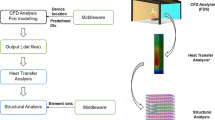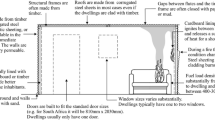Abstract
Understanding the fire behaviour in buildings is fundamental and crucial to the practice of structural fire safety design. Traditionally, time-temperature curves associated with a burning rate developed from the “compartment fire framework” are most widely used by structural engineers and applied as a load to the structure. However, the adequacy of homogenous temperature distribution in fully developed fires was questioned by researchers after reviewing the existing fire test data, which suggested a localised burning nature of the fires in relatively large compartments. A groundbreaking travelling fire concept and travelling fire models were then proposed intending to provide an engineering description to this type of natural fire behaviour. The work in this paper was driven by such a trend and first summarises the modelling infrastructure in OpenSees to estimate the thermal response of structural members subjected to various scenario fires, followed by providing a smart application interface to capture the appropriate form of natural fire model through Python-OpenSees framework. The developed modelling infrastructure is validated against uniform and localised fire tests, which are also discussed regarding the smoke effect afterwards. Using the Python-OpenSees infrastructure, a real-scale localised fire test and the Malveira travelling fire test are modelled to demonstrate the modelling strategy. The work as preliminary attempts has shown the necessity of introducing additional variables when describing the natural fire impact, and this framework can be further improved in future by including more fire dynamics research and full-scale fire test input.













Similar content being viewed by others
References
Torero JL, Majdalani AH, Cecilia AE, Cowlard A (2014) Revisiting the compartment fire. Fire Saf Sci 11:28–45. https://doi.org/10.3801/IAFSS.FSS.11-28
Stern-Gottfried J, Rein G, Bisby LA, Torero JL (2010) Experimental review of the homogeneous temperature assumption in post-flashover compartment fires. Fire Saf J 45(4):249–261. https://doi.org/10.1016/j.firesaf.2010.03.007
Drysdale D (2011) An introduction to fire dynamics. Wiley, New York
Bisby L, Gales J, Maluk C (2013) A contemporary review of large-scale non-standard structural fire testing. Fire Sci Rev 2(1):1–27. https://doi.org/10.1186/2193-0414-2-1
Hidalgo JP, Cowlard A, Abecassis-Empis C, Maluk C, Majdalani AH, Kahrmann S, Hilditch R, Krajcovic M, Torero JL (2017) An experimental study of full-scale open floor plan enclosure fires. Fire Saf J 89:22–40. https://doi.org/10.1016/j.firesaf.2017.02.002
Hidalgo JP, Goode T, Gupta V, Cowlard A, Abecassis-Empis C, Maclean J, Bartlett AI, Maluk C, Montalvá JM, Osorio AF, Torero JL (2019) The Malveira fire test: full-scale demonstration of fire modes in open-plan compartments. Fire Saf J 108:102827. https://doi.org/10.1016/j.firesaf.2019.102827
Stern-Gottfried J, Rein G (2012) Travelling fires for structural design-Part I: literature review. Fire Saf J 54:74–85. https://doi.org/10.1016/j.firesaf.2012.06.003
Stern-Gottfried J, Rein G (2012) Travelling fires for structural design-Part II: design methodology. Fire Saf J 54:96–112. https://doi.org/10.1016/j.firesaf.2012.06.011
Dai X, Jiang L, Maclean J, Welch S, Usmani A (2016) A conceptual framework for a design travelling fire for large compartments with fire resistant islands, In: Proceedings of the 14th international interflam conference, no. October, Windsor, pp 1039–1050
Dai X, Welch S, Vassart O, Cabova K, Jiang L, Maclean J, Clifton G, Usmani A (2020) An extended travelling fire method (ETFM) framework for performance-based structural design. Fire Mater 44(33):1–21. https://doi.org/10.1002/fam.2810
Heidari M, Kotsovinos P, Rein G (2020) Flame extension and the near field under the ceiling for travelling fires inside large compartments. Fire Mater 44:423–436. https://doi.org/10.1002/fam.2773
Dai X, Welch S, Usmani A (2017) A critical review of travelling fire scenarios for performance-based structural engineering. Fire Saf J. https://doi.org/10.1016/j.firesaf.2017.04.001
Jahn W, Rein G, Torero JL (2008) The effect of model parameters on the simulation of fire dynamics. Fire Saf Sci. https://doi.org/10.3801/IAFSS.FSS.9-1341
ANSYS (2009) Release 12.0. ANSYS
ABAQUS (2002) ABAQUS/CAE User’s Manual, Hibbitt. Karlsson & Sorensen, Incorporated
Huang Z, Burgess IW, Plank RJ (2003) Modeling membrane action of concrete slabs in composite buildings in fire. I: theroretical development. J Struct Eng 129(8):1103–1112. https://doi.org/10.1061/(ASCE)0733-9445(2003)129:8(1103)
Franssen J (2005) SAFIR: A thermal/structural program for modelling structures under fire. Eng J (3):143–158
McKenna F, Fenves GL, Scott MH Others, Open system for earthquake engineering simulation, University of California, Berkeley, CA
Usmani A, Zhang J, Jiang J, Jiang Y, May I (2012) Using opensees for structures in fire. J Struct Fire Eng 3(1):57–70. https://doi.org/10.1260/2040-2317.3.1.57
Jiang Y (2012) PhD Thesis: Development and application of a thermal analysis framework in OpenSees for structures in fire, Phd thesis, The Univeristy of Edinburgh
Jiang J, Jiang LM, Kotsovinos P, Zhang J, Usmani A (2015) OpenSees software architecture for the analysis of structures in fire. J Comput Civ Eng 29(1):1–13. https://doi.org/10.1061/(ASCE)CP.1943-5487.0000305
Jiang L, Usmani A (2018) Computational performance of beam-column elements in modelling structural members subjected to localised fire. Eng Struct 156:490–502
Jiang L, Usmani A (2018) Towards scenario fires-modelling structural response to fire using an integrated computational tool. Adv Struct Eng 21(13):2056–2067. https://doi.org/10.1177/1369433218765832
CEN (2002) EN 1991-1-2:2002: Eurocode1: actions on structures. General actions-actions on structures exposed to fire
Hasemi Y, Yoshida M, Yokobayashi Y, Wakamatsu T (1997) Flame heat transfer and cocurrent flame spread in a ceiling fire. In: Fire safety science–proceedings of the fifth international symposium, pp 379–390. https://doi.org/10.3801/IAFSS.FSS.5-379
Wakamatsu T, Hasemi Y (1988) Heating mechanism of building components exposed to a localized fire–FDM thermal analysis of a steel beam under ceiling. Fire Saf Sci 3:335–346
Wakamatsu T, Hasemi Y, Kagiya K, Kamikawa D (2003) Heating mechanism of unprotected steel beam installed beneath ceiling and exposed to a localized fire: verification using the real-scale experiment and effects of the smoke layer. In: Fire safety science–proceedings of the seventh international symposium, international association for fire safety science, pp 1099–1110
Lattimer B (2016) Heat fluxes from fires to surfaces. National Fire Protection Association, New York
Rackauskaite E, Hamel C, Law A, Rein G (2015) Improved formulation of travelling fires and application to concrete and steel structures. Structures 3:250–260. https://doi.org/10.1016/j.istruc.2015.06.001
Ousterhout JK, Jones K (2009) Tcl and the Tk toolkit. Pearson Education, London
Zhu M, McKenna F, Scott MH (2018) OpenSeesPy: python library for the OpenSees finite element framework. SoftwareX 7:6–11. https://doi.org/10.1016/j.softx.2017.10.009
Lim L, Wade C (2002) Experimental fire tests of two-way concrete slabs, Tech. rep., BRANZ limited, New Zealand
CEN (2004) BS EN 1992-1-2:2004: Eurocode 2: Design of concrete structures. Generic rules-structural fire
Lim L, Buchanan A, Moss P, Franssen J-M (2004) Numerical modelling of two-way reinforced concrete slabs in fire. Eng Struct 26(8):1081–1091. https://doi.org/10.1016/j.engstruct.2004.03.009
CEN (2005) BS EN1993-1-2:2005: Eurocode 3: desgin of steel structures. General rules-structural fire design
NIST (2008) NIST NCSTAR 1A: Final Report on the Collapse of the World Trade Center Building 7, Tech. rep., NIST
Yarlagadda T, Hajiloo H, Jiang L, Green M, Usmani A (2018) Preliminary modelling of Plasco Tower collapse. Int J High-Rise Build 7(4):397–408. https://doi.org/10.21022/IJHRB.2018.7.4.397
Mockus J (2012) Bayesian approach to global optimization: theory and applications, vol 37. Springer, New York
Snoek J, Larochelle H, Adams RP (2012) Practical bayesian optimization of machine learning algorithms. In: Pereira F, Burges CJC, Bottou L, Weinberger KQ (eds) Advances in neural information processing systems 25. Curran Associates Inc, New York, pp 2951–2959
Hopkin C, Consultants OFR, House J, Street H (2019) A review of design values adopted for heat release rate per unit area. Fire Technol 55(5):1599–1618. https://doi.org/10.1007/s10694-019-00834-8
Acknowledgements
The authors of this paper would like to acknowledge Dr Frank Mckenna for his continuous support in extending OpenSees for modelling structures in fire. The financial support from the University Start-up Fund (P0031564) to the first author of this paper is gratefully acknowledged.
Author information
Authors and Affiliations
Corresponding author
Additional information
Publisher's Note
Springer Nature remains neutral with regard to jurisdictional claims in published maps and institutional affiliations.
This paper is submitted to the Special Issue on Smart Systems in Fire Engineering.
Rights and permissions
About this article
Cite this article
Jiang, L., Jiang, Y., Zhang, Z. et al. Thermal Analysis Infrastructure in OpenSees for Fire and its Smart Application Interface Towards Natural Fire Modelling. Fire Technol 57, 2955–2980 (2021). https://doi.org/10.1007/s10694-020-01071-0
Received:
Accepted:
Published:
Issue Date:
DOI: https://doi.org/10.1007/s10694-020-01071-0




